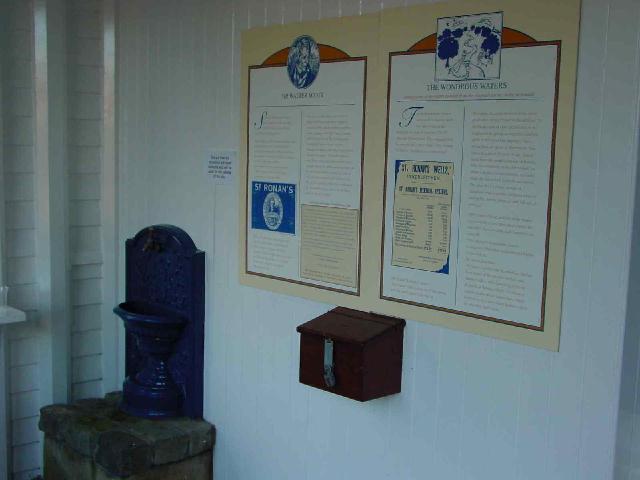
2/11/03- bit posh eh?!

2/11/03- bit posh eh?!

2/11/03-the well house frontage showing the two towers either side of the main wellhouse and the coat of arms

2/11/03- the cistern

2/11/03-on the veranda- the interpretive boards and cistern
Sunday 2/11/03
A more grand and glorious well house would be hard to imagine- resplendent in the St. Ronan’s colours of sky-blue and white with a huge royal coat of arms and flagpole. Unfortunately the well house closes for the season on the 19th October, however, on the veranda you can still partake of the mineral waters from a cast iron cistern built into the wall. There are also a couple of interpretive panels highlighting the connections with Robert Burns and Sir Walter Scott. The spa house was built in 1827, but the curative mineral water of the wells must have been a magnet for thousands of years.
From the Imperial Gazetteer of Scotland, 1868;
The spa does not appear to have been remarked for its medicinal properties till about the commencement of the present century. Till then it was noted chiefly or altogether as the resort of pigeons from the circumjacent country, and bore the name of the Doo-well. Had any saint in the Romish calendar been acquainted with it, the priests of the age preceding the Reformation would have pictured him to their gullible flocks as performing a far different exploit in connexion with its waters, than that which Meg Dods ascribes to the patron saint of ‘the Aulton’ in reference to St. Ronan’s Well, and would hardly have failed to send down to posterity the fame of miracles achieved by the naturally salutiferous properties of its waters. Even after it came into late notice, the well was a trivial, repulsive-looking fountain, bubbling up amidst a little marsh; and had no better appliance than a rude bench placed at its side for the accommodation of the infirm invalids who crept or were carried to it in quest of health. A simple pump afterwards rose gauntly from its mouth, amidst the wet miry puddle around it. But about 35 years ago, or not much earlier, the spa, with remarkable suddenness, and in a way nearly unaccountable, became celebritous among valetudinarians of all classes in Edinburgh and throughout the south of Scotland. The well, in the decorations built over and around it, in the character assigned it by popular opinion, and in the influence it exerted on the village in its vicinity, now rose, as if by magic, from the status of a watery hole in a quagmire, to that of an infant competitor with the proud spas of England. In 1824, the publication of Sir Walter Scott’s tale of St. Ronan’s Well, greatly enhanced its celebrity, and poured down upon it some rays of that lustre which popular opinion then assigned to ‘the Great Unknown;’ for nearly all the readers of light literature, in spite of the utter difficulty which a topographist would have felt to discover resemblances, unhesitatingly identified the Marchthorn and the St. Ronan’s of the tale with Peebles and Innerleithen. The well springs up at the base of the Lee-pen, about 200 feet above the village. In its original state, it issued in small quantities, and at only one spring; but, when the ground was dug to its source, in order to clear away admixtures near the surface, it became emitted in two streams of different strength. On analysis, a quart of the less impregnated stream was found to contain 5.3 grains of carbonate of magnesia, 9.5 grains of muriate of lime, 21.2 grains of muriate of soda,--in all, 36 grains; and a quart of the other stream, 10.2 grains of carbonate of magnesia, 19.4 of muriate of lime, and 31 of muriate of soda,--in all. 60.6 grains. The waters, jointly with the salubrious influence of the fine climate, are efficacious chiefly in cases of ophthalmic complaints, old wounds, and dyspeptic and bilious disorders.
From the NSA 1845;
‘This mineral spring was formerly called the ‘Dow-well’, its water is now recognised as curative and it is resorted to by many visitors. Had it been known in ancient times as a medicinal water, without doubt the clergy would have taken advantage of that fact and dedicated it to some saint.‘
As indeed they did- and it now bears the name of St. Ronan.
Description, directions and opening times































